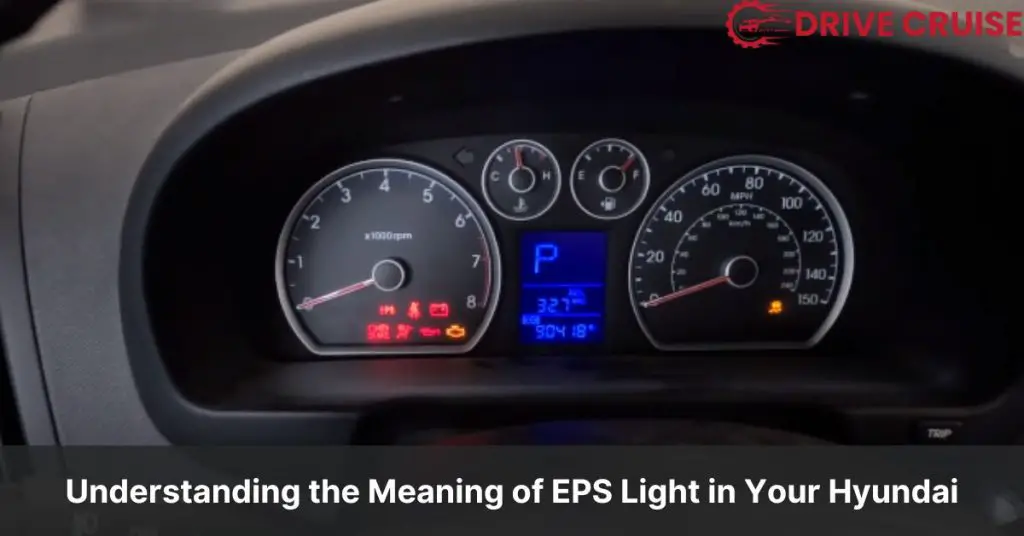Gazing at the illuminated EPS light on your Hyundai’s dashboard can be unnerving. EPS stands for Electronic Power Steering, a crucial system that assists with steering effort. But a malfunctioning EPS can significantly impact handling. This guide delves into the meaning of the EPS light on Hyundai vehicles, explores potential causes, and provides valuable insights for diagnosis and rectification.
If you see the EPS light illuminated on your Hyundai’s dashboard, it means there is an issue with the power steering system. The light comes on when the car is turned on, and it should turn off after a few seconds. However, if the light stays on for an extended period, it indicates a problem that requires attention.
The EPS light can be triggered by various issues, including a defective sensor, damaged power steering pump, or wiring issues. In some cases, the EPS light might also come on due to a faulty EPS motor, which is responsible for rotating the steering gear to help you turn the wheel. In the next section, we’ll explore some of the most common causes of the EPS light on Hyundai vehicles, and how to diagnose and rectify them.
Demystifying the EPS Light: A Hyundai-Specific Breakdown
If you own a Hyundai, you might have encountered the EPS light on your dashboard. This light serves as a warning indicator for potential issues within the Electronic Power Steering system. Here’s a breakdown of possible reasons behind the EPS light illumination:
Sensor Malfunction
If you notice that the EPS light illuminates, and you experience increased steering effort, making turns more difficult, especially at low speeds, or a feeling of vagueness or reduced responsiveness in the steering wheel, it could be due to a sensor malfunction. The following are the possible causes:
- Faulty Steering Angle Sensor: This sensor monitors the steering wheel’s position and relays information to the EPS control unit. A malfunctioning sensor can disrupt the system’s ability to provide appropriate steering assistance.
- Torque Sensor Issues: The torque sensor measures the force applied to the steering wheel. A faulty torque sensor can send inaccurate data to the EPS control unit, leading to inconsistencies in steering assist.
Electrical Issues
If you notice that the EPS light illuminates, and you encounter intermittent or complete loss of power steering assistance, or erratic steering behavior, making it difficult to maintain control of the vehicle, it could be due to electrical issues. The following are the possible causes:
- Electrical Wiring Faults: Damaged or corroded wiring within the EPS system can disrupt communication between components and lead to malfunctions.
- Faulty EPS Control Unit: The EPS control unit is the brain of the system, processing sensor data and regulating power steering assist. A malfunctioning control unit can cause various EPS issues.
Other Potential Causes
If you notice that the EPS light illuminates, and none of the above issues seem to be the cause, it could be due to the following:
- Low Battery Voltage: In rare cases, a failing battery with insufficient voltage can trigger the EPS light, although steering functionality might not be significantly impacted.
- Loose Connections: Loose electrical connections within the EPS system can disrupt communication and lead to warning light illumination.
Navigating the EPS Light: What to Do Next
If you’re driving your Hyundai and the EPS light comes on, it’s important to take immediate action to ensure your safety and the safety of others on the road. Here’s what you should do next:
Pull Over Safely
Your first priority should be to pull over safely. Find a safe location to pull over as soon as possible and turn off the engine. This will help prevent any further damage to the EPS system and ensure your safety.
Consult Your Owner’s Manual
Your Hyundai owner’s manual will provide specific information regarding the EPS light and any recommended actions. Take some time to review the manual and familiarize yourself with the EPS system and its warning lights.
Visual Inspection (if safe to do so)
If it’s safe to do so, check for any visible signs of damage around the steering column or electrical components near the firewall (where the engine compartment meets the passenger compartment). This may help you identify any obvious issues that could be causing the EPS light to illuminate.
Seek Professional Help
Given the safety implications of a malfunctioning EPS system, it’s crucial to seek assistance from a qualified mechanic or Hyundai dealership for proper diagnosis and repair. Don’t attempt to operate the vehicle with a persistent EPS light. A qualified technician will be able to diagnose the issue and provide a solution to get you back on the road safely.
Keeping Your Hyundai’s Steering Precise: Preventive Measures
Regular Maintenance
Regular maintenance is crucial to ensure that your Hyundai’s EPS system is functioning properly. Schedule regular appointments with a qualified mechanic to have your EPS system inspected and serviced. During these appointments, your mechanic will check for any signs of wear and tear, leaks, or other issues that could potentially cause problems with your EPS system. Regular maintenance will help you catch any issues early on, before they become more serious and costly to repair.
Warning Light Awareness
It is important to be familiar with the EPS light symbol on your Hyundai’s dashboard. The EPS light is an indicator that there is a problem with your EPS system. If the light illuminates, take immediate action and have your car inspected by a qualified mechanic. Ignoring the EPS light can lead to more serious problems with your car’s steering and potentially put you in danger while driving.
Avoid Modifications
Refrain from installing aftermarket steering wheel components or electrical modifications that could potentially interfere with the EPS system. Modifications may cause damage to the EPS system and can cause the EPS light to illuminate. Stick with the original equipment manufacturer (OEM) parts and avoid any modifications that could potentially cause problems with your EPS system.
Regular maintenance, warning light awareness, and avoiding modifications are all important measures to keep your Hyundai’s steering precise. By following these steps, you can ensure that your car’s EPS system is functioning properly and avoid any potential problems while driving.
Conclusion
In conclusion, the EPS light on your Hyundai is an important warning that should never be ignored. The light indicates a potential issue with the Electronic Power Steering system, which can have a significant impact on your vehicle’s steering and control.
If you notice the EPS light in your Hyundai Elantra, it could be due to a faulty EPS motor. Replacing the motor usually solves the problem. The EPS Motor is responsible for rotating the steering gear with some force to help you turn the wheel. If the EPS motor fails, it will not send power to the steering wheel.
Apart from a faulty EPS motor, there are several other reasons why the EPS light may come on in your Hyundai. These include damaged wiring, corroded connectors, fuse issues, and steering component wear and tear. It is important to have your vehicle inspected by a qualified mechanic to identify the root cause of the problem.
Related Posts:







